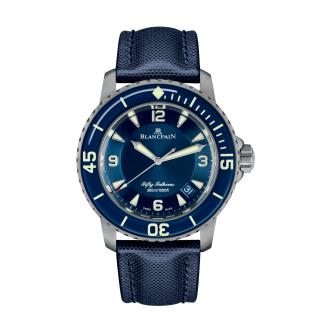The calm before the storm
It’s five in the afternoon in the Mediterranean Sea. The gentle lapping of the waves bears little resemblance to the powerful swell that, until recently, churned beneath the bow as the anemometer recorded gusts of up to 35 knots. The golden hand of my Fifty Fathoms, strapped to my wrist by its unbreakable salt-washed NATO band, doesn’t lie: we’ve just weathered 12 hours on the tempestuous sea. The mistral that buffeted us with thick, salty spray has died down as our boat makes its way back to the Provençal coast, between Toulon and Saint Tropez. In the unexpected calm, the ship has righted itself, and the crew have resumed their positions, scanning the horizon with the binoculars slung around their necks.
Look! Over there! A water spout!
That’s the signal. A wave of excitement sweeps the deck. Some point towards the northwest, while our seasoned captain steers into the wind with quiet competence. Then, silence and anticipation. I watch the half-white, half-red tip of the second hand on my watch, anchoring myself in the moment. Twenty minutes pass. The creature has vanished but the anticipation remains, our eyes narrowed towards a horizon distorted by the sun. Then suddenly, a spout, then another, and another – sprays of water betrayed by the shimmering mist they cast above the azure expanse. With each new spout, we adjust our course, gradually drawing nearer to the colossal creatures whose mass beneath the waves we can only guess at.

A legendary beast emerges
The anticipation amongst our crew, members of the Swiss Cetacean Society, is palpable. Through the binoculars, we spot two fin whales, each about twenty metres long. A common dolphin (an endangered species) makes an appearance, showing off its yellow belly as it somersaults beneath the bow. More blue and white dolphins (stenellae coeruleoalbae) dart gracefully around two foaming trails: the last vestiges of the whales which, after filling their lungs with oxygen, have dived back into the depths with a final flick of their tail fins.
And now the countdown begins until their next appearance. I pull on my freediving suit, fasten my lead weight belt and adjust the hood over my mask, before making the final adjustments to my underwater camera. As I slip on my long white fins at the back of the boat, I scan the horizon, awaiting the captain’s signal to dive. I catch myself daydreaming as I observe the warm reflections of the sunset over the sea. I lose myself in the unique reverse moire dial of this prestigious Blancpain timepiece, displaying a spectrum of intense blues, from bright sky blue to deepest navy. I barely register the titanium watch case on my wrist, yet the precise lines framing its generous 45mm diameter provide a reassuring solidity in the face of the vastness beneath me.

Diving with the watch
The beast emerges 100 metres away. A few revs of the engine bring us close enough for scientific ethics. I dive in. My heart pounds with excitement, exertion, and apprehension at the prospect of coming so close to a whale for the first time. I paddle breathlessly, but then my leg kicks gradually align with my breathing. One, two, inhale. One, two, exhale. The sun has set and I’m almost lost in the liquid night that has suddenly enveloped me. Underwater, only the screen of my camera and the luminescence of my watch’s numerals and hands guide me. The quarter-hour markers on the ceramic bezel, which I had previously rotated, allow me to keep track of my time underwater. Because, of course, another countdown has begun since the fin whale surfaced; it usually only stays at the surface to breathe for about fifteen minutes before disappearing once more.
Despite my best efforts, I started my dive too far from the creature to get a close-up. The whale continues to swim away, and my feeble leg kicks are not enough to close the gap. I manage to take an accidental snapshot of one of the dolphins, and a grey-white blob in the distance.
But it was still an incredible experience to be in the presence of such a majestic creature, and to sense its colossal propulsion through the water. It is also humbling to have followed in the footsteps of legendary explorers such as Jacques Cousteau and Laurent Ballesta, who both regularly dived with their Fifty Fathoms watches.

A legendary timepiece
In the following days, as I attempted once again to capture the effervescence of the ocean depths on camera, my gaze was inevitably drawn to the azure gradients of the watch’s dial. Carried by the swell, one of the most sublime pleasures of diving is the feeling of becoming one with the water. As I focus on my breathing, the clattering of shells, plankton, crabs, and the underwater rumblings of distant creatures send shivers down my spine. In this near-trance state, I can drift for hours, playing with the currents like an amphibious creature. The subtle yet vibrant blue reflections of the Fifty Fathoms are in perfect harmony with the waters that hold me in their spell.
P.S: The scene unfolds in August 2023, 15 nautical miles from the Ile des Embiez, around the Pelagos Triangle. Bordered by the Côte d’Azur, Monaco, Liguria, Corsica and northern Sardinia, the 87,500 km2 area was declared a sanctuary for marine mammals in 1999 by the surrounding countries, and designated a “Specially Protected Area of Mediterranean Importance” (ASPIM). But without appropriate resources or specific regulations, this label doesn’t mean much. That is where organisations like the Swiss Cetacean Society play a crucial role. This organisation conducts global data collection campaigns on cetacean populations and regularly recruits eco-volunteers and specialist naturalist supervisors. Anyone is free to join the ranks of the Lausanne-based institution in the field, and the participation of eco-volunteers is vital for its financial independence.







